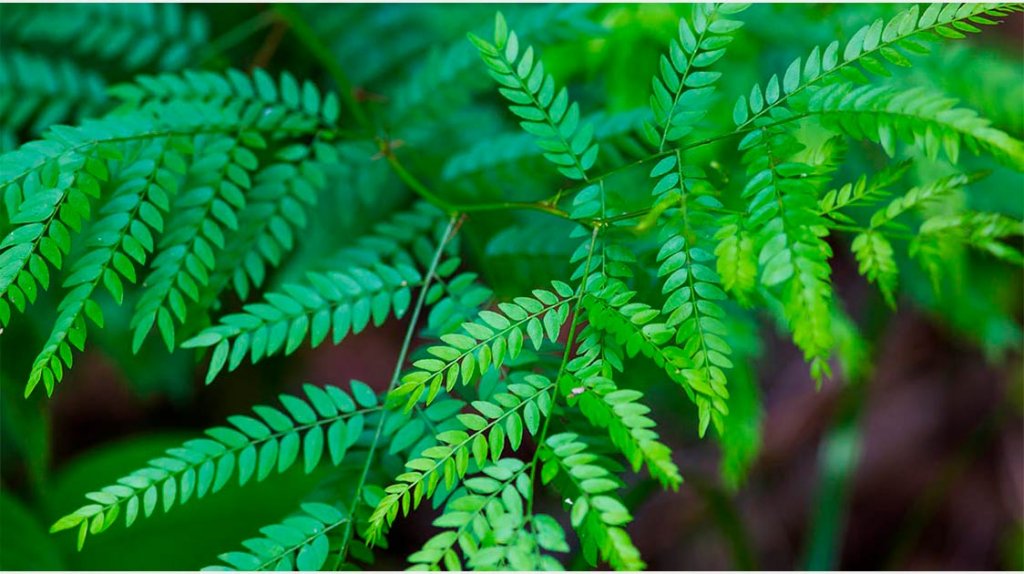Locust trees belong to a family of Plants called Fabaceae. They are a type of fast-growing flowering plant with a lifespan of more than a hundred years.
Locusts are known for their exceptionally durable wood, sweet-smelling, showy, fragrant spring flowers hanging in loose clusters, and vibrant fall foliage.
They have one of the hardest woods compared to the strongest deciduous trees.
Some species of Locusts come with long, sharp thorns, but thornless species are also found. They occur commonly in North America and Mexico.
Black Locusts (Robinia pseudoacacia), often referred to as false acacia, Yellow Locusts, and honey Locusts (Gleditsia triacanthos), also from the pea family, are some forms that are cultivated as ornamentals. Some are also used for erosion control and as timber trees.
Locust timber is excellent for making furniture, flooring, interiors, small boats, and fencing. Black locust wood is more commonly used than honey locust wood. Apart from growing as long plants, they also grow as shrubs.
There are many natural varieties and cultivars, but all of them fall into two genera, namely, Robinia and Gleditsia.
The Black Locust fall belongs to the genus Robinia, while the famous Honey Locust belongs to the Gleditsia genera. But these are not the only Locust Trees there is.
In this article, we will discuss a variety of Locust trees that are widely found around the globe in different parts of the world.
Types of Locust Trees with Identification Guide
There are about 16 different types of locust tree cultivars identified, all derived from 2 basic types- Honey Locusts (Gleditsia triacanthos) and Black Locusts (Robinia pseudoacacia)
These two varieties are endemic to the North American region and can be differentiated by the presence of thorns on barks and branches. Black Locusts have smaller thorns, while Honey locusts generally have bigger thorns.
In the following sections, we will explore all the other types of locusts, including the ones discussed above. We will see their differentiating characteristics and learn how to identify them.
1. Honey Locust Trees (Gleditsia Triacanthos)
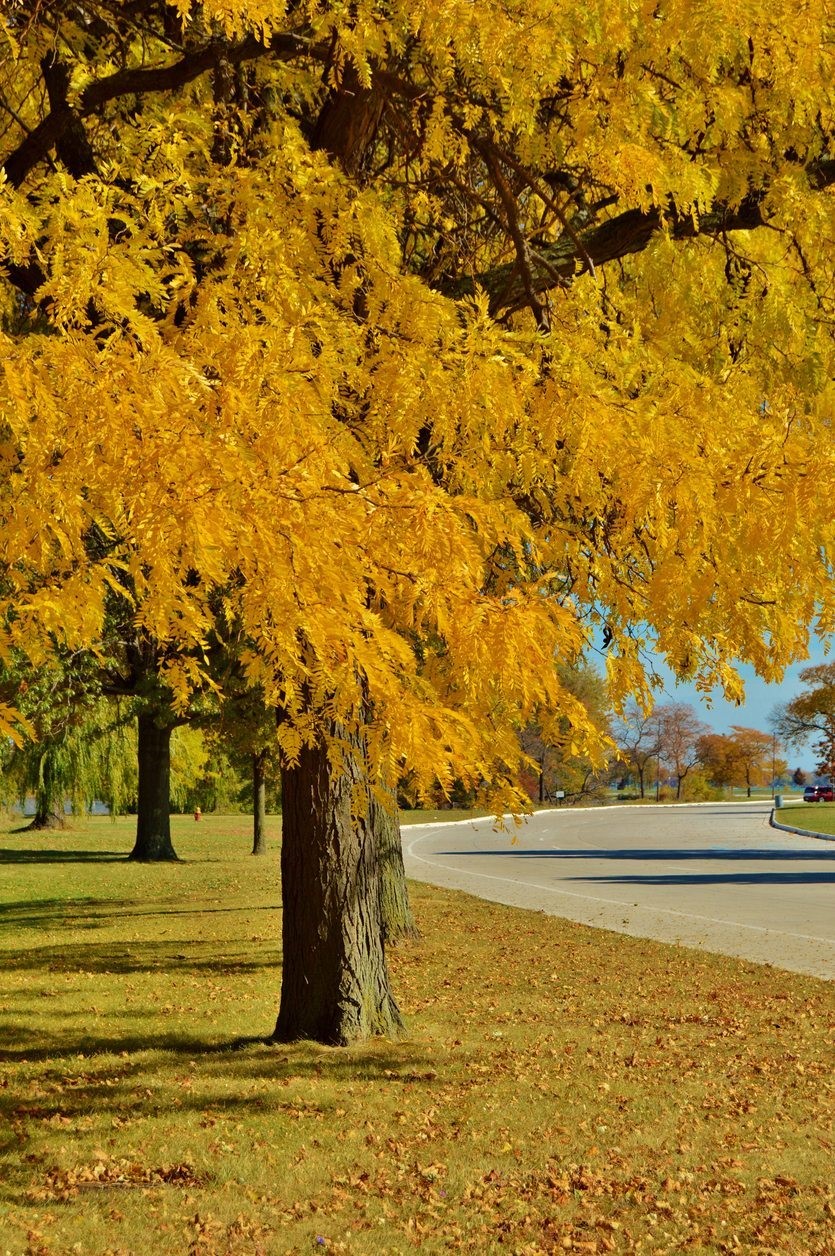
Honey Locust trees are fast-growing, deciduous trees with a hard bark, thriving in various environments, especially in full sun. They are native to regions like Pennsylvania, Iowa, Texas, and Georgia in the United States.
Typically reaching heights between 66 and 100 feet, these trees are notable for their thorny branches, which can grow 4 to 8 inches long. Known as “Thorny Locusts,” they are popular in garden landscapes for their ornamental beauty, characterized by vibrant yellow foliage in the fall and an ability to form expansive shade with widely spaced branches and small leaves.
Identification Guide:
-
- Leaves: The leaves emerge slightly earlier than those of Black Locusts, without a leaflet at the tip. They are a lighter shade of green.
- Flowers: Produces small, creamy-green, fragrant flowers in inconspicuous clusters in late spring to early summer. The seeds are found in flat, dark, purplish-brown, corkscrew-twisted pods, about 10-18 inches long.
- Bark: Initially grey-brown to red-brown to bronze, smooth with horizontal lenticels, evolving into long, narrow, curling plates. It often has clusters of large, branched thorns on the trunk.
2. Imperial Honey Locust (Gleditsia triacanthos f. inermis ‘Impcole’)
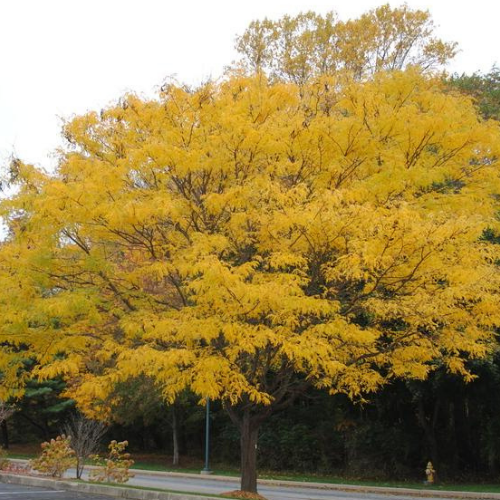
The Imperial Honey Locust is a thornless variety of the Honey Locust tree, growing up to 40 feet in height and 35 feet in spread. This deciduous tree is favored for lawns and streets due to its large canopy and lack of thorns.
It features a ferny structure with a yellow-green tinge and is resilient across a range of environmental and soil conditions, including saline, dry, and windy conditions.
Identification Guide:
- Leaves: Bright green, feather-like, pinnately compound leaves, which turn golden yellow in the fall.
- Flowers: Produces small clusters of greenish-white florets in late spring and early summer.
- Bark: The bark is gray to brown, suitable for crafting furniture and woodwork.
3. Bristly Locust Tree (Robinia hispida)
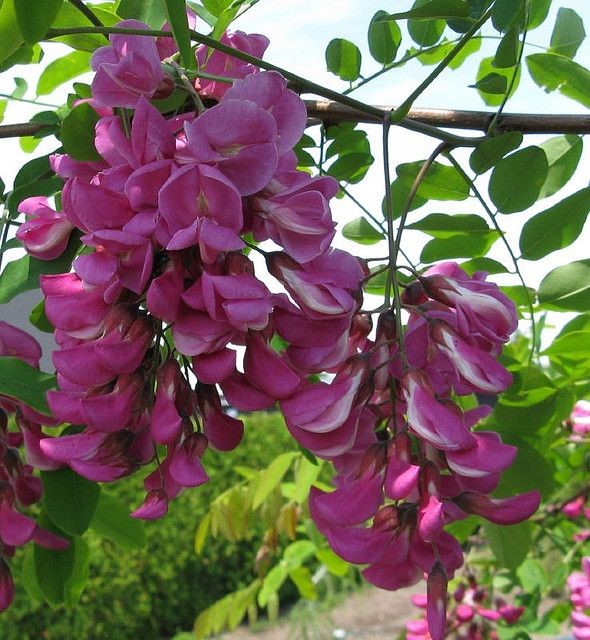
The Bristly Locust is a large flowering shrub, characterized by its pink pea-like scented flowers, compound leaves, and reddish-brown seed pods. It’s known for its fast-growing nature and intricate root system, making it invasive in many states.
Common names include most locust and rose acacia. With a maximum height of around 10 feet and a spread of up to 15 feet, it’s an ideal choice for small garden spaces, offering dense groundcover in sunny areas.
Identification Guide:
- Leaves: Pinnately compound leaves that thrive in full sun and well-drained soil.
- Flowers: Produces purple-pink pendulous flowers in late spring and early summer, attracting bees and other pollinators.
- Bark: Young plants have a smooth, gray bark with small, fine purple-brown hairs, giving a bristly appearance.
- Uses: Known for its role in erosion control and its wood is used for constructing fences and other artifacts.
7. New Mexico Locust (Robinia neomexicana)
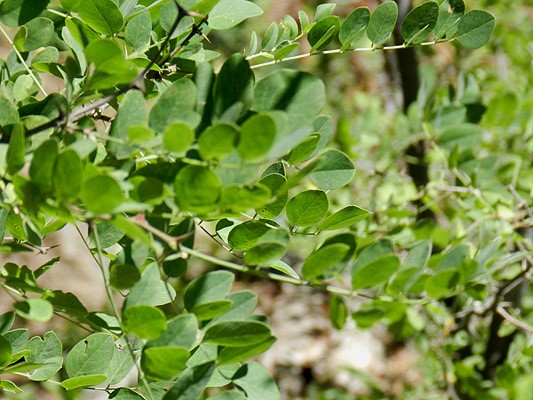
Native to the southwestern United States, including Colorado, Arizona, Utah, and New Mexico, the New Mexico Locust is a versatile plant that can be cultivated as either a shrub or a tree.
It typically grows between 16 to 32 feet in height. This species is distinguished by its clusters of purple-pink flowers that bloom in late spring and early summer, offering a beautiful scent and attracting pollinators.
Identification Guide:
- Leaves: The leaves are fern-like, between 4 and 6 inches long, with a dark green color and small hairs or bristles, giving a grayish appearance.
- Flowers: Light purple and pink flowers, distinct from the white flowers of most Robinia species, make it a popular choice for warm climate garden landscapes.
- Bark: The bark is light gray-brown with shallow furrows.
- Growth Habit: Thick, large branches with clusters of flowers blooming from spring to summer.
8. Black Locust Trees (Robinia pseudoacacia)
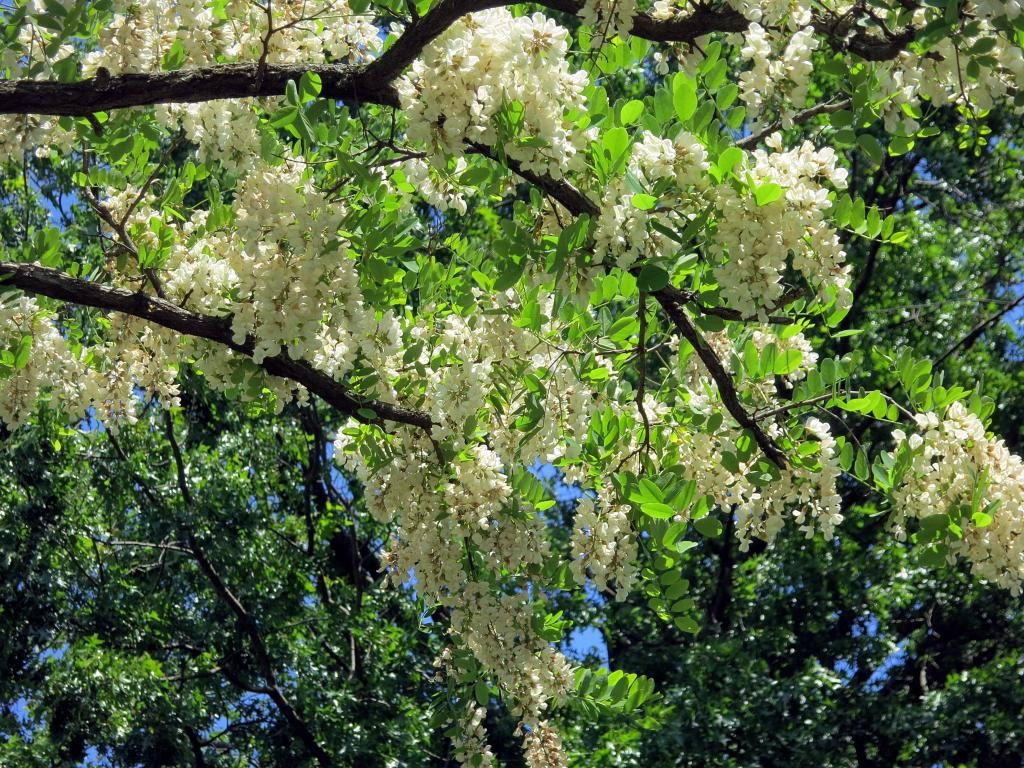
Black Locust trees are hardy, deciduous trees native to North America. Known for their versatility, they are used for decorative purposes and timber production. Growing well in sunny locations, they can withstand drought, poor soil quality, and damp environments, commonly found along riverbanks and in woodlands.
These trees typically reach heights of 40-100 feet, with some varieties growing up to 171 feet. Known as “False Acacia,” “Common Robinia,” or “Fragrant White Locust,” they have a historical significance in woodworking, especially in shipbuilding.
Identification Guide:
- Leaves: Pinnately compound and dark green, growing up to 10 inches long.
- Flowers: Produce clusters of white, fragrant flowers in spring, a nectar source for bees.
- Bark: Deeply furrowed, brown-gray in color with reddish grooves. Young trees have sharp spines at the leaf bases.
- Toxicity: Leaves, bark, branches, and seed pods are toxic.
- Wood: Known for its strength and durability, commonly used in furniture and fencing.
9. Frisia Black Locust (Robinia pseudoacacia ‘Frisia’)
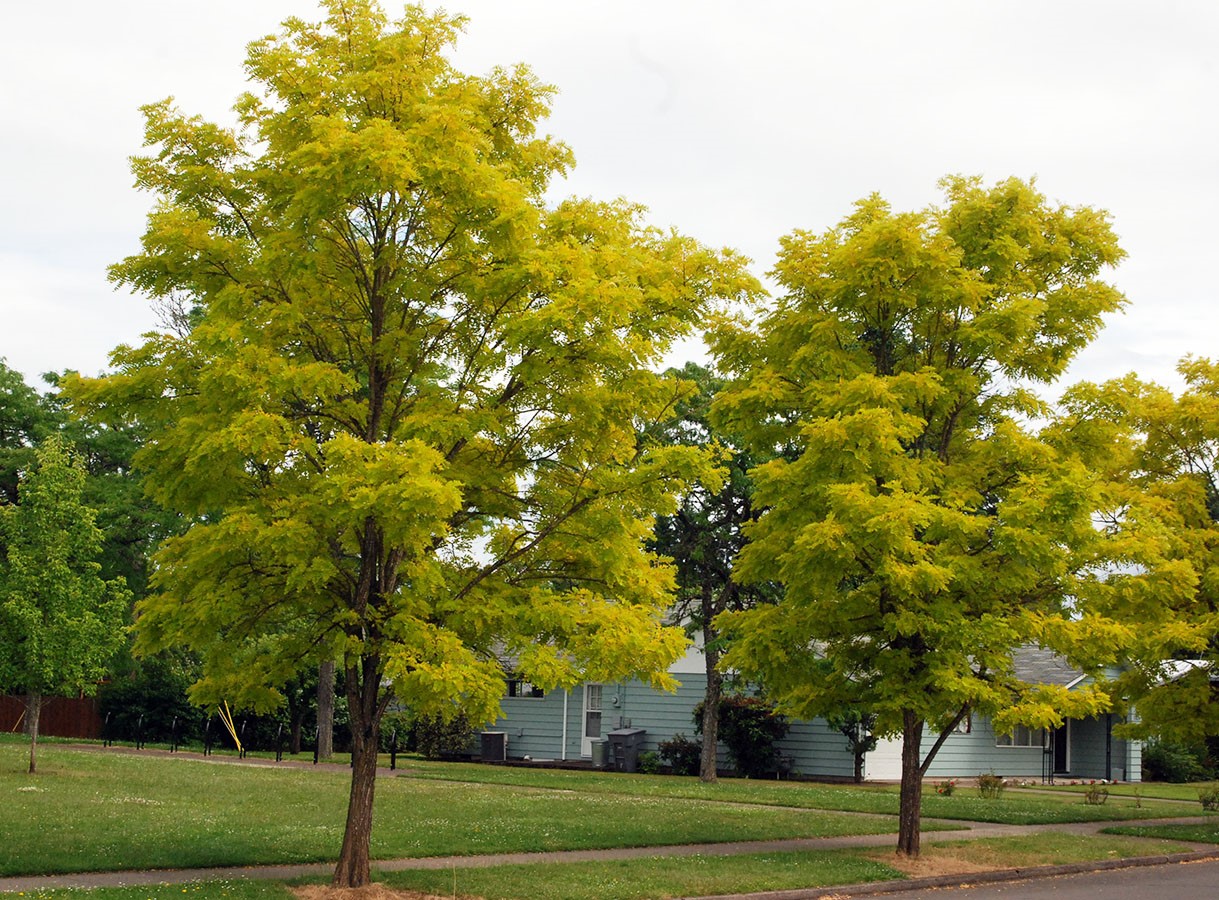
The Frisia Black Locust is a deciduous tree variant of the Black Locust, growing up to 40 feet in height and spreading approximately 25 feet.
This species is recognized for its oval shape and upright branches. It is especially noted for its vibrant foliage, which appears bright yellow in spring, transitioning to greenish-yellow in summer.
Identification Guide:
- Leaves: Golden-yellow bijugate leaves, distinctive for their color change throughout the seasons.
- Flowers: Dense clusters of fragrant white flowers, 4 to 8 inches long, attracting bees. These flowers are excellent for honey production.
- Bark: Features wine-red prickles or thorns on young shoots.
- Seed Pods: Dark red to black, leathery seed pods, 2 to 4 inches long, persisting through winter.
- Wood: Extremely strong and durable, suitable for woodworking. However, the branches are brittle and can be damaged in high winds.
- Diseases: Susceptible to canker, leaf spot, and powdery mildew.
10. Twisty Baby Black Locust (Robinia pseudoacacia “Lace Lady”)
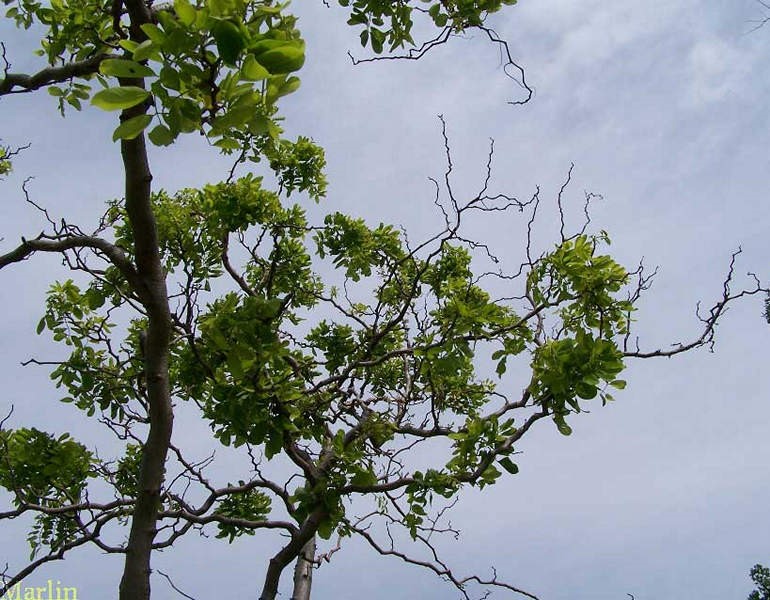
The Twisty Baby Black Locust, also known as the Lace Lady, is a unique variety characterized by its contorted branches. This compact, garden-scale tree or shrub is notable for its delicate foliage and contorted growth habit.
It’s an excellent focal point in gardens, particularly in winter when its bare, twisted branches create a striking visual.
Identification Guide:
- Leaves: Oval, pinnately compound leaves that turn yellow in the fall, growing up to 10 feet in length with a 12-foot spread.
- Growth Habit: Compact with a low canopy, providing a clearance of about 2 feet from the ground.
- Bark: Twisted black and brown branches add significant interest, especially in winter.
- Characteristics: Spineless and sparse-flowering, adding a fine and delicate texture to the landscape.
11. Purple Robe Black Locust (Robinia pseudoacacia ‘Purple Robe’)
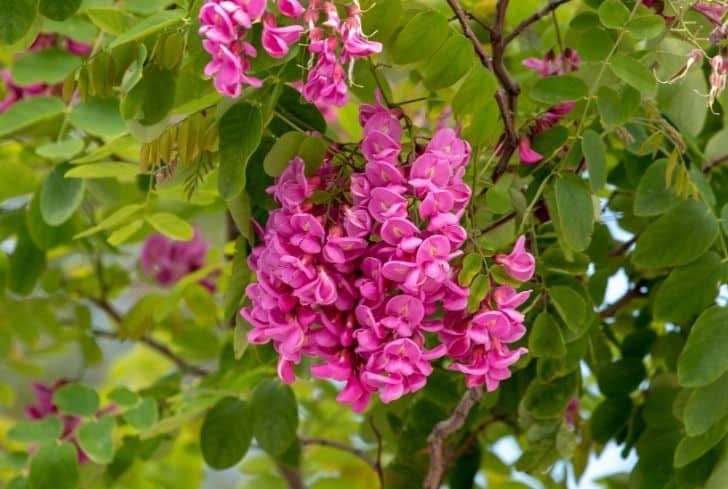
The Purple Robe Black Locust stands out for its strikingly beautiful purple flowers and young red leaves, which undergo a color transformation to blue-green and then yellow in the fall.
It typically grows between 30 and 40 feet in height with a similar spread, making it an ideal choice for garden landscapes, particularly for providing shade due to its fern-like foliage and widely spaced branches.
Identification Guide:
- Leaves: Metallic red when immature, turning to deep green or bluish-green, and finally yellow in the fall.
- Flowers: Produces clusters of pink-purple flowers that hang from the branches, adding vibrant colors to gardens.
- Growth Habit: Drought-resistant with hard wood, a characteristic common to many locust trees.
- Wood: Suitable for various applications due to its strength and durability.
12. Skyline Honey Locust (Gleditsia triacanthos ‘Skycole’)
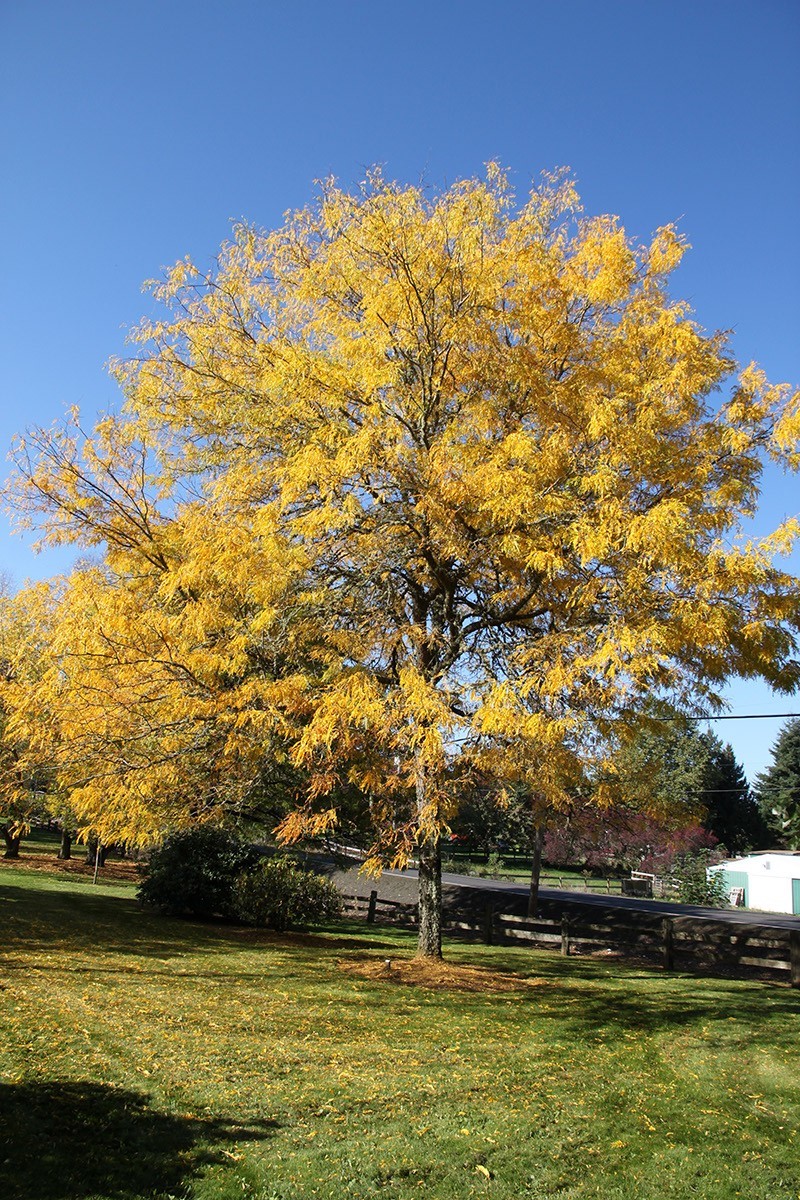
The Skyline Honey Locust is a popular shade tree, recognized for its pyramid-like shape and delicate, fern-like structure. It grows up to 45 feet in height with a canopy spread of about 25 feet.
This tree is known for its adaptability to a range of challenging conditions, including full sun, high heat, and various soil types, making it an ideal choice for urban street planting.
Identification Guide:
- Leaves: Pinnate or bipinnate with small, ovate leaflets. The foliage transitions from dark green in summer to beautiful yellow in fall.
- Flowers: Produces inconspicuous greenish-white flowers in May and June, leading to long, twisted, purple seed pods containing a sweet substance.
- Growth Habits: Fast-growing, able to withstand drought, poor soil conditions, high salt concentrations, and urban pollution.
- Bark: Features a spiky trunk with thorned branches.
13. Sunburst Honey Locust (Gleditsia triacanthos var. inermis ‘Suncole’)
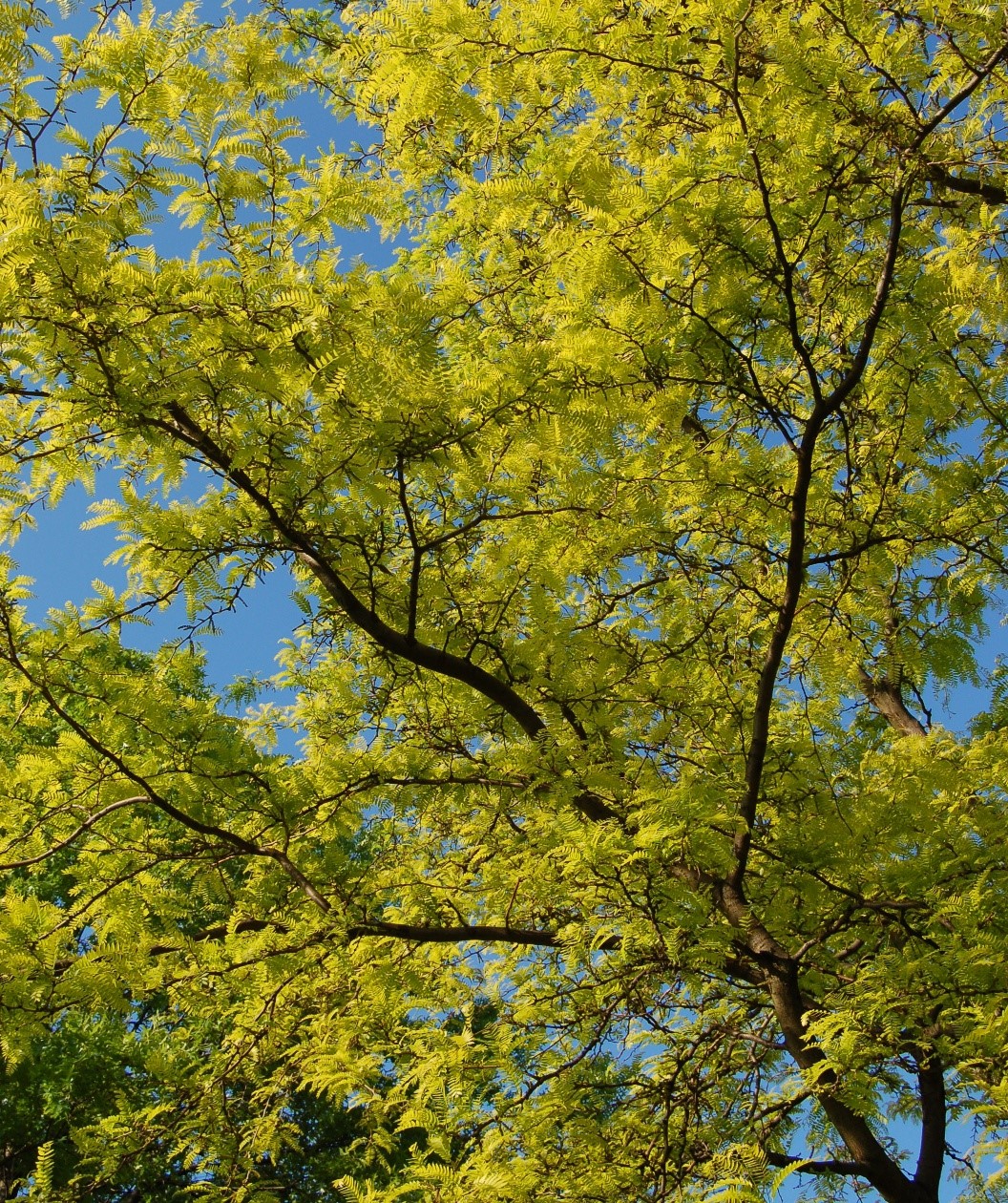
The Sunburst Honey Locust is a deciduous tree variety, renowned for its attractive feathery foliage that provides excellent shade.
This thornless cultivar (‘inermis’ indicates its thornless nature) reaches up to 40 feet in height, making it shorter than native varieties. It’s particularly valued for its ornamental qualities and ease of maintenance due to the absence of thorns and pods.
Identification Guide:
- Leaves: Pinnate with fine texture, changing color through various growth stages.
- Flowers: Greenish-yellow, adding sweet fragrance and vibrant color to gardens.
- Growth Habits: Suitable for lawns and shade applications; grows more quickly than many other locust trees.
- Characteristics: Lacks thorns and is pod-less, offering low maintenance and ease of care.
14. Shademaster Honey Locust (Gleditsia triacanthos var. inermis ‘Shademaster’)
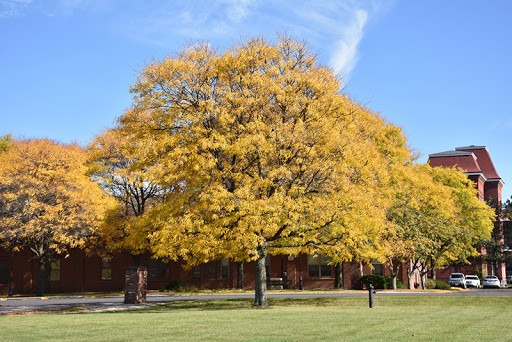
The Shademaster Honey Locust is a thornless and pod-less variety, ideal for lawns or as a shade tree. This tree is known for its rapid growth and wide canopy, reaching up to 75 feet in height with a canopy span of 40 feet.
It is an excellent choice for providing ample shade without completely obstructing sunlight, thanks to its finely textured, pinnate leaves.
Identification Guide:
- Leaves: Small leaflets that turn yellow in the fall, allowing light to filter through while providing shade.
- Flowers: Small, delicate with a yellowish tinge, contributing to the tree’s ornamental value.
- Growth Habits: Fast-growing, with an extensive canopy providing excellent shade.
- Characteristics: Thornless and pod-less, making it a low-maintenance option for urban and residential settings.
15. Thornless Honey Locust Tree (Gleditsia triacanthos f. inermis)
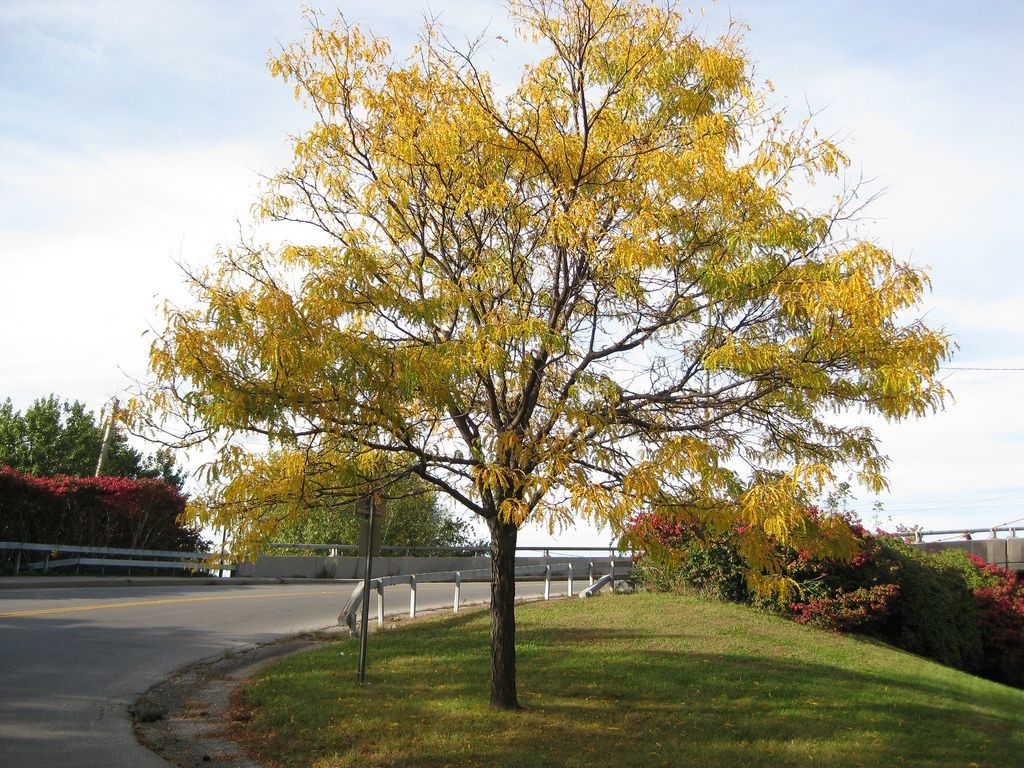
The Thornless Honey Locust is an elegant variety known for its beautiful foliage and vibrant, sweet-scented flowers.
This ‘inermis’ cultivar is devoid of sharp spikes on its bark, making it a safer choice for public and residential areas. It is well-suited for garden settings, where its ornamental qualities can be fully appreciated.
Identification Guide:
- Leaves: Pinnate or bipinnate, lending a delicate texture to the tree’s overall appearance.
- Flowers: Produce vibrant flowers that attract honeybees and other pollinators, enhancing the biodiversity of the area.
- Growth Habits: Adaptable to various environmental conditions, including drought and poor soil quality.
- Bark: Smooth and spike-free, ensuring a safe interaction for both people and wildlife.
16. Ruby Lace Thornless Honey Locust (Gleditsia triacanthos var. inermis ‘Ruby Lace’)
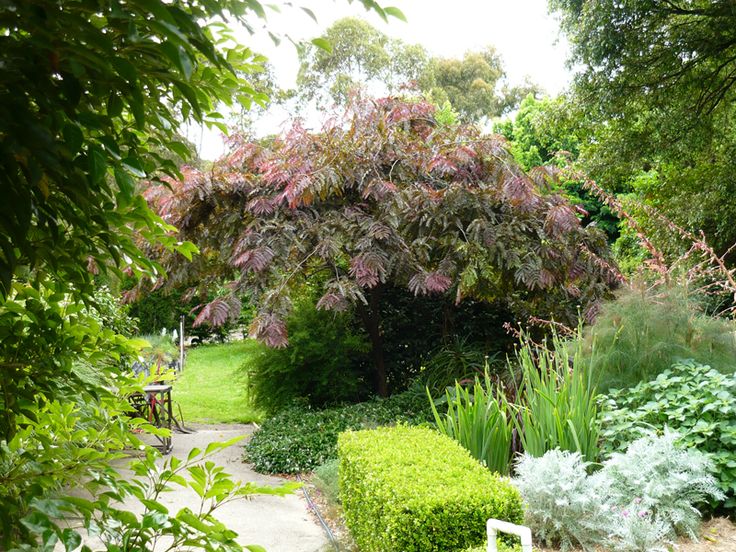
The Ruby Lace Thornless Honey Locust is a distinctive variety known for its vibrant, ruby red young leaves, which add a unique color palette to any landscape.
This tree is highly adaptable and resistant, thriving in conditions such as drought and high salt environments. Primarily grown as an ornamental plant, it’s a stunning addition to patios and landscape features.
Identification Guide:
- Leaves: Start with a ruby red color in spring, transitioning through hues of pink, orange, and purple as they mature, eventually turning dark, bronzed green in summer.
- Growth Habit: Deciduous, upright, and columnar, typically growing to a height of 16 feet and a width of 8 feet when planted in the ground. Suitable for pot planting for more controlled growth.
- Adaptability: Flourishes in both full and partial sunlight, providing dappled shade and visual interest in a garden setting.
- Characteristics: Known for its adaptability to various conditions, making it a versatile choice for different landscape designs.
Wrapping Up
Each variety, from the stately Black Locust to the ornamental Ruby Lace Thornless Honey Locust, presents its own unique set of characteristics, uses, and aesthetic appeals.
Understanding these different types of locust trees is not just about appreciating their beauty or utility; it’s also about recognizing their role in various ecosystems and landscapes.
As we conclude, we hope this guide has provided valuable insights into identifying and appreciating the diverse members of the locust tree family, each contributing in its own way to the beauty and diversity of our environment.

